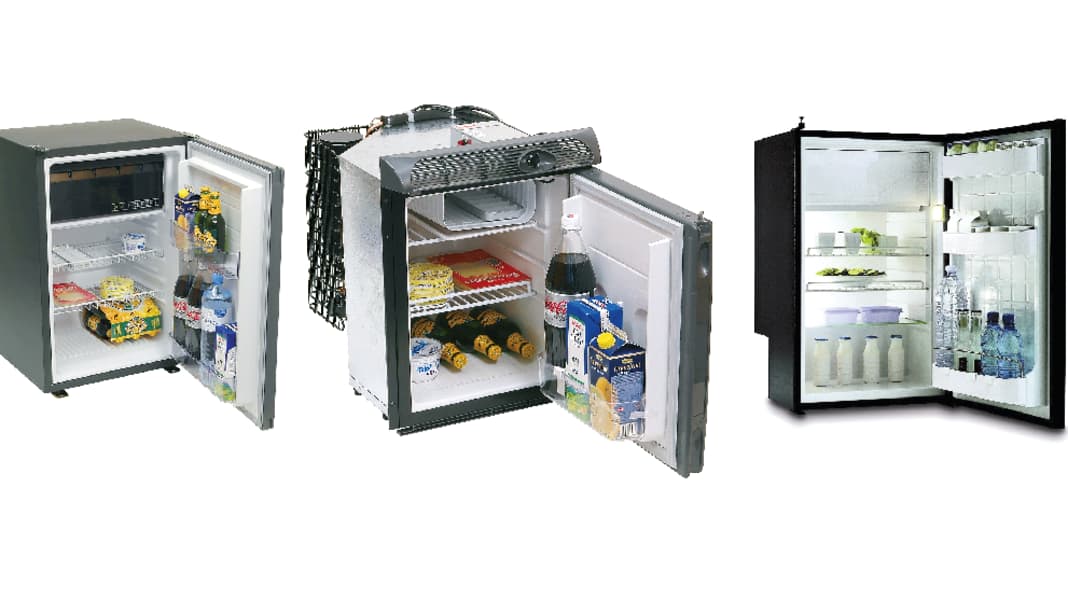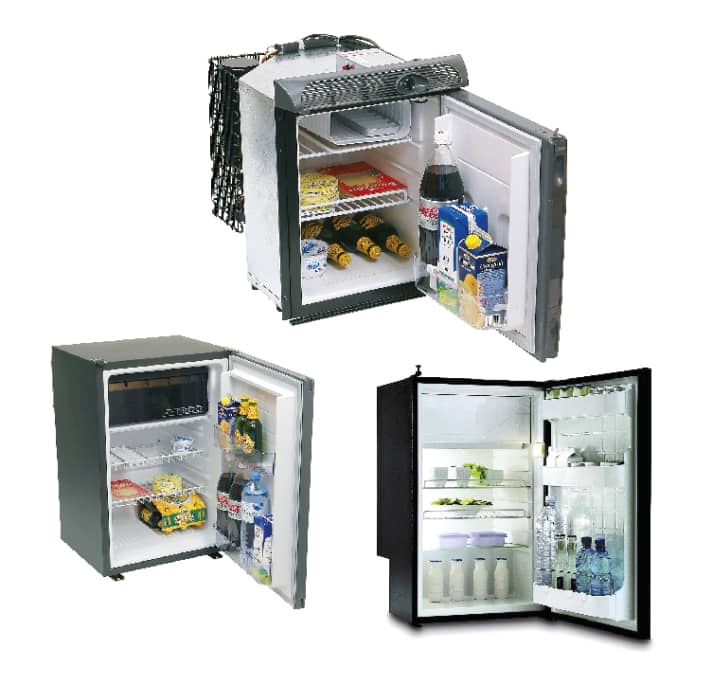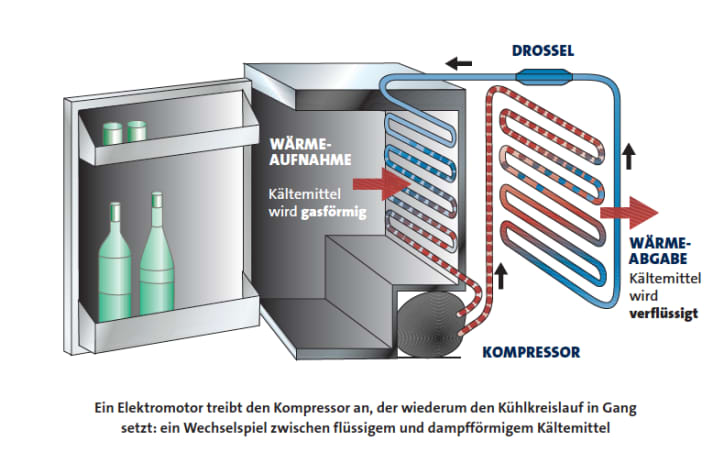
The invention of the refrigerator has radically changed the lives of mankind. It made it possible for the first time to artificially generate cold in practically any location and thus store perishable food for long periods of time.
Around 10 years after the introduction of the first household appliances, mobile refrigerators and cabinets for use on boats came onto the market in the mid-1960s. There are basically three types of mobile refrigeration systems:
1. thermoelectric devices
2. absorber appliances
3. compressor appliances
The first principle is the simplest method and is mainly used in the leisure and car sector: A special cooling element (Peltier element) is supplied with electricity from the vehicle electrical system, which cools it down on one side. However, the disadvantages of this method are relatively high power consumption and low cooling capacity.

In principle, Peltier elements can only keep the internal temperature of the cool box a maximum of 17 °C lower than the ambient temperature. If the ambient temperature is 35 °C, for example, the internal temperature of the Peltier box will remain at 18 °C in the best case scenario. Too much to protect food from spoiling. The more powerful absorption refrigerators use heat for cooling. This sounds absurd at first, but becomes understandable when you analyse their function.
The heat, generated either electrically or by gas, causes a special refrigerant to vaporise. This gas passes through pipes into the so-called condenser and from there into an evaporator inside the refrigerator. During this process, the coolant becomes liquid again and removes the heat from the cold room. The gas-powered version of this process is mainly used in the camping sector or in mobile homes, as gas appliances are often available here anyway.
For boats, the absorber principle can only be used to a very limited extent because the refrigerator must be as level as possible and must not sway in order to function properly. The last method of refrigeration is the most efficient and is therefore used in all household and most boat refrigerators: the compressor refrigeration process (see also drawing). In this process, a liquid refrigerant evaporates under high pressure and absorbs the heat from the inside of the refrigerator.

An electric compressor then compresses the refrigerant vapour again. The refrigerant then condenses in a condenser on the rear wall of the refrigerator, releasing heat into the environment. This is also the reason why compressor refrigerators must not be hermetically sealed and require ventilation. Whether the already installed refrigerator needs to be replaced or you simply want to retrofit a refrigerator, retailers have a wide range of appliances available.
These range from a wide variety of cool boxes in simple Peltier versions to the more effective compressor box. These devices are easy to take on and off board and can be used as a "food bag" from home. Once on board, they are either placed in storage boxes (must be ventilated) or in the floor area of the boat. The latter is particularly annoying, as the boxes quickly restrict your freedom of movement.
In this respect, the built-in refrigerator is better: they are installed in pantry blocks or cupboards and do not interfere with the floor space. A distinction is made between drawer and conventional door appliances, which we have summarised in this market overview. Everyone is familiar with this type of refrigerator from their own kitchen. However, the models for boats are not as large, as the space on board is much more limited. Our table therefore only lists the most common appliances with capacities between 40 litres and around 80 litres....
These sizes are installed in most boats between 20 and 35 feet. The installation dimensions can be used to make a preselection, as the refrigerator can only be added to the wish list if it really fits. Wemo advertises its 62 model as having dimensions that are particularly common in American and Scandinavian boats. This makes it an ideal replacement appliance. At Waeco, the customer can choose between different installation frames, which not only make the devices easy to install, but also make them look more elegant later on. Another note: The dimensions of our compact appliances refer to the installation dimensions with integrated compressor. There are also other versions in which the compressor is installed in a separate location.
The layout of the refrigerator with shelves and door compartments is important for on-board use. This includes such simple things as space for the milk carton, which should fit as upright as possible in the cabinet. Or fruit and vegetables, which should not be allowed to roll around in the fridge but should be stored in drawers, as is the case with some Waeco appliances. To provide drinks with ice cubes, every refrigerator has an ice compartment. The Isotherm Classic 40 Cube, which can be used either as a cooling or freezing unit, has a special position. All ice compartments are suitable for making ice cubes. However, when it comes to storing frozen food for several weeks, only the Waeco CR 50, 65 and 80 appliances are suitable, as they operate at a minimum temperature of -18 °C.

These appliances have three stars and their temperature is in the range of household appliances that keep food fresh for several months. Two-star appliances (-12 °C), such as the Engel CK-100 and Isotherm Cruise Classic 40, can store food for around three weeks and one-star appliances for around a week. This star stands for at least -6 °C. However, the first task of a refrigerator is to keep the food in the normal cold room between 3 and 7 °C, which all appliances can do according to the data sheet.
A very important point here is power consumption. It almost goes without saying that you have to work with a second battery if you have a refrigerator on board, because the starter battery should never be misused for the on-board power supply. Otherwise, starting problems are inevitable. The current consumption (at 12 V) of the refrigerators varies between 2.7 A and 7 A, which poses no real problems for the electrical installation.
Much more important is the statement about energy consumption.
There is a rule of thumb for this: the consumption at an outside air temperature of 25 °C and an internal refrigerator temperature of 5 °C (can be set with a dial on all appliances) is used as a basis and then the number of kilowatt hours or watt seconds per day (table value) required to maintain the 5 °C is calculated. This value depends on the efficiency of the cooling circuit and the insulation. For the latter, everyone relies on the material polyurethane (PU). One manufacturer calls it PU rigid foam, the next PU solid foam, but ultimately the same chemical compound is used everywhere.
In terms of consumption, it is noticeable that the Waeco appliances from CR 50 have a higher value. However, this additional consumption is obvious - operating a freezer compartment at -18 °C simply requires more energy. How long does a battery last without recharging? Here is an example: a battery with a nominal charge of 70 Ah and a refrigerator with an energy consumption of 0.340 kWh per day. In order for conventional lead batteries to achieve a long service life, they should not be discharged too deeply. Hence the assumption that we take 42 Ah (60 %), which with 12 V × 42 Ah results in an energy storage volume of 0.504 kWh. From this, 0.504 kWh divided by 0.340 kWh per day results in an operating time of 1.5 days, = 36 hours.
If you forget to switch off the fridge in time, there is no problem, except for the Engel appliances, because all other products have an undervoltage protection that switches the fridges off automatically and thus protects the batteries.

